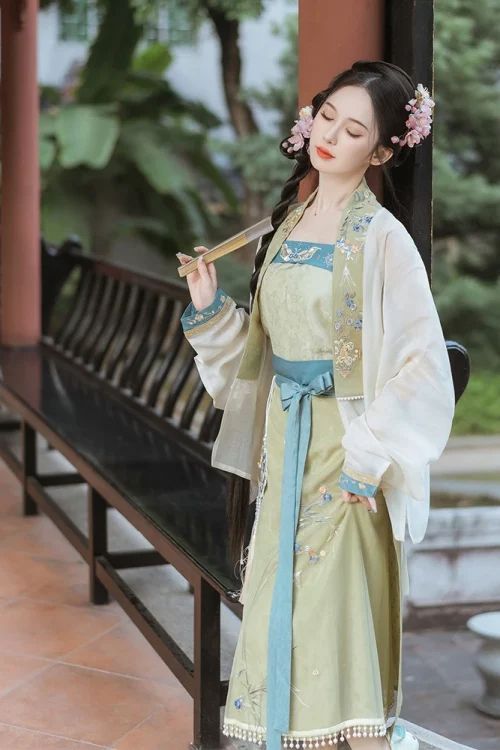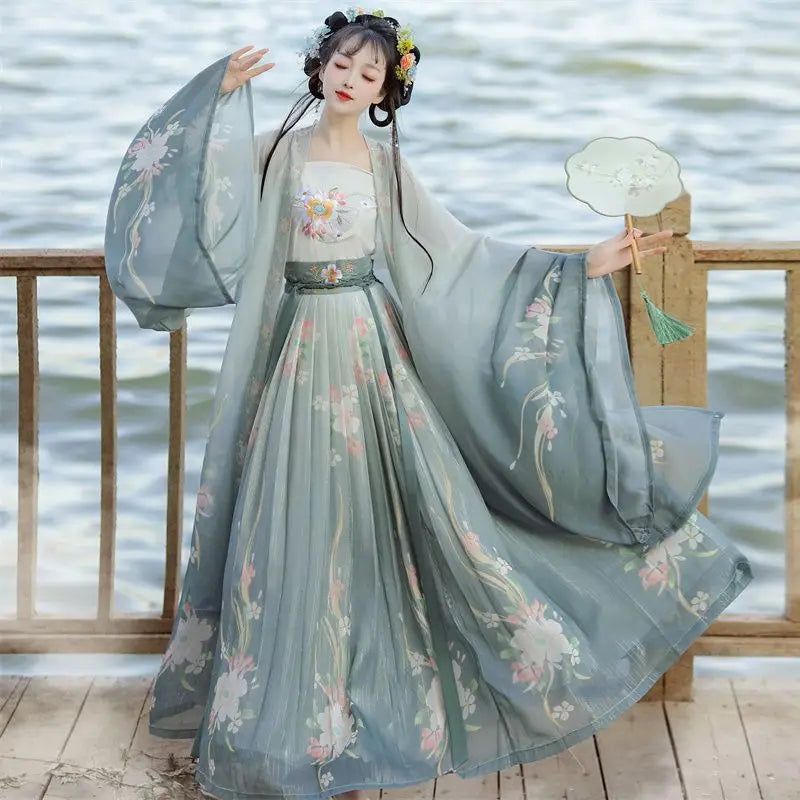Reviving Song Dynasty Hanfu: A Journey into the Past and Present
The Song Dynasty (960-1279) marked a golden age in Chinese history, renowned for its cultural advancements and exquisite aesthetics. Among its many contributions, the Song Dynasty left an enduring legacy in the form of Hanfu, the traditional Chinese clothing. In recent years, there has been a growing revival of Song Dynasty Hanfu, driven by a desire to reconnect with China’s rich cultural embrace its timeless beauty.

Cultural Movement
The revival of Song Dynasty Hanfu is not merely a fashion trend but a cultural movement that seeks to preserve and promote Chinese traditions. Hanfu enthusiasts, known as “Hanfuzi,” have dedicated themselves to studying historical texts, researching ancient techniques, and recreating authentic Song Dynasty garments. They gather at cultural events, festivals, and online communities to share their knowledge and showcase their creations.
Fusion of Past and Present
The contemporary revival of Song Dynasty Hanfu has also been influenced by modern aesthetics and sensibilities. Designers have incorporated contemporary elements into traditional designs, creating garments that are both historically accurate and stylish. This fusion of past and present has resulted in a vibrant and diverse range of Hanfu styles, catering to the tastes of both traditionalists and fashion-forward individuals.
Cultural Significance
Beyond its aesthetic appeal, the revival of Song Dynasty Hanfu carries significant cultural importance. It represents a growing appreciation for Chinese history and a desire to preserve its intangible heritage. By wearing Hanfu, individuals not only express their personal style but also connect with their cultural roots and contribute to the preservation of a centuries-old tradition.
Economic Impact
The revival of Song Dynasty Hanfu has also positively impacted the Chinese textile industry. The demand for authentic fabrics and traditional craftsmanship has led to a resurgence of traditional weaving and dyeing techniques. This has not only preserved ancient skills but also created new economic opportunities for artisans and businesses.
Balancing Tradition and Modernity
As the revival of Song Dynasty Hanfu continues to gain momentum, it is important to strike a balance between historical authenticity and contemporary relevance. While preserving the essence of traditional designs is crucial, it is equally important to adapt them to modern lifestyles and aesthetics. By embracing innovation while respecting tradition, the revival of Song Dynasty Hanfu can continue to thrive as a vibrant and meaningful cultural expression.
The Cultural Significance of Song Dynasty 汉服: Embracing Heritage in Modern Times
The Song Dynasty (960-1279) marked a golden age in Chinese history, renowned for its cultural advancements and artistic achievements. Among its many contributions, the Song Dynasty left an enduring legacy in the form of Hanfu, the traditional Chinese clothing. In recent years, there has been a growing revival of Song Dynasty Hanfu, driven by a desire to reconnect with cultural heritage and embrace contemporary fashion trends.

Vibrant Expression of Cultural Identity
The revival of Song Dynasty Hanfu is not merely a nostalgic pursuit but a vibrant expression of cultural identity. Hanfu embodies the aesthetics and values of the Song Dynasty, characterized by its flowing lines, elegant embroidery, and intricate patterns. By donning Hanfu, individuals can immerse themselves in the rich history and traditions of their ancestors.
Interest in Traditional Craftsmanship
Moreover, the revival of Song Dynasty Hanfu has sparked a renewed interest in traditional Chinese craftsmanship. The intricate embroidery and delicate fabrics used in Hanfu require skilled artisans to create. This revival has provided a platform for these artisans to showcase their talents and preserve traditional techniques.
Fashion Trend
Beyond its cultural significance, Song Dynasty Hanfu has also become a popular fashion trend. Contemporary designers have incorporated elements of Hanfu into modern clothing, creating a fusion of traditional and modern aesthetics. This trend has not only made Hanfu more accessible to a wider audience but has also fostered a greater appreciation for Chinese culture.
Enduring Power of Cultural Heritage
The revival of Song Dynasty Hanfu is a testament to the enduring power of cultural heritage. It demonstrates the ability of traditional garments to transcend time and inspire contemporary fashion. By embracing Hanfu, individuals can not only connect with their cultural roots but also contribute to the preservation and evolution of Chinese traditions.
Ensuring Cultural Integrity
As the revival of Song Dynasty Hanfu continues to gain momentum, it is important to ensure that it remains rooted in its cultural origins. By promoting authentic designs and traditional craftsmanship, we can preserve the integrity of this ancient art form while fostering a vibrant and inclusive fashion landscape.
Contemporary Trends in Song Dynasty Hanfu: Innovation and Authenticity
The Song Dynasty (960-1279) marked a golden age in Chinese history, renowned for its cultural advancements and exquisite aesthetics. Among its many contributions, Song Dynasty Hanfu, the traditional clothing of the era, stands out as a testament to the period’s refined taste and craftsmanship. In recent years, there has been a resurgence of interest in Song Dynasty Hanfu, driven by a desire to reconnect with China’s rich cultural heritage and a growing appreciation for its timeless beauty.

Balancing Innovation and Authenticity
Contemporary trends in Song Dynasty Hanfu reflect a delicate balance between innovation and authenticity. While traditional designs and fabrics remain highly valued, modern designers are incorporating contemporary elements to create garments that are both stylish and respectful of the past. For instance, traditional silk and brocade fabrics are often complemented with modern materials such as lace and chiffon, adding a touch of lightness and modernity to the classic silhouettes.
Renewed Interest in Traditional Techniques
The revival of Song Dynasty Hanfu has also sparked a renewed interest in traditional Chinese embroidery and weaving techniques. Intricate patterns and motifs, once reserved for the elite, are now being incorporated into a wider range of garments, making them accessible to a broader audience. This revival not only preserves these ancient skills but also fosters a deeper appreciation for the artistry and craftsmanship that went into creating these garments.
Symbol of Cultural Identity
Beyond its aesthetic appeal, the revival of Song Dynasty Hanfu has also become a symbol of cultural identity and pride. In a rapidly globalizing world, many Chinese people are turning to traditional clothing as a way to express their connection to their heritage. By wearing Hanfu, they not only showcase the beauty of Chinese culture but also contribute to its preservation and transmission to future generations.
Challenges to Authenticity
However, the revival of Song Dynasty Hanfu is not without its challenges. Some purists argue that the incorporation of modern elements dilutes the authenticity of the garments, while others worry that the trend could become commercialized and lose its cultural significance. It is important to strike a balance between innovation and authenticity, ensuring that the revival of Song Dynasty Hanfu remains rooted in its cultural heritage while also embracing contemporary sensibilities.
Respecting Tradition
As the revival of Song Dynasty Hanfu continues to gain momentum, it is essential to approach it with respect and understanding. By embracing both traditional and modern elements, we can create garments that are both beautiful and meaningful, fostering a deeper appreciation for China’s rich cultural heritage while also contributing to its ongoing evolution.
